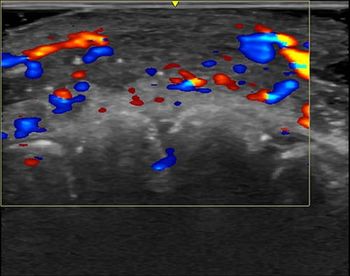
Report from SIR: Interventionalists assess fluorescing stem cells to treat peripheral vascular disease
Using biotechnology developed from fireflies and seaweed, Johns Hopkins researchers are developing radiopaque stem cells for targeted delivery of therapy in patients with peripheral arterial disease. The technique may allow guidance and tracking of stem cell injections meant to grow new blood vessels and offer a way to confirm therapy response.
Using biotechnology developed from fireflies and seaweed, Johns Hopkins researchers are developing radiopaque stem cells for targeted delivery of therapy in patients with peripheral arterial disease. The technique may allow guidance and tracking of stem cell injections meant to grow new blood vessels and offer a way to confirm therapy response.
About eight million people over the age of 40 in the U.S. suffer from peripheral vascular disease, according to the American Heart Association. The rate climbs to nearly 20% among those aged 65 and older. Without proper treatment, PVD can lead to more serious vascular events such as gangrene, myocardial infarction, stroke, and death.
Catheter-based angioplasty and stenting have proved efficacious for opening vessels and helping some patients avoid more invasive management approaches ranging from atherectomy to limb amputation. Other patients suffer from massive disease, however, that limit their interventional options.
Report from SIR: Interventionalists assess fluorescing stem cells to treat peripheral vascular disease
A study presented at the 2009 Society of Interventional Radiology meeting in San Diego suggests that image-guided stem cell therapy could give interventional radiologists a new tool to help patients by enabling a minimally invasive approach, said coauthor Dr. Dara L. Kraitchman, an associate professor of radiology at Johns Hopkins University. By injecting stem cells into the legs of patients with diseased arteries, the researchers hope to stimulate the growth of new blood vessels and thus improve circulation.
"This is another adjunct treatment that IRs could be giving to their patients," Kraitchman told Diagnostic Imaging. "This is all designed to be used under fluoroscopy, which is an imaging modality that they are very comfortable with."
The investigators faced several challenges. They had to find a way that allowed image-guided delivery of stem cells near the vessels that needed repair. They also needed a method that showed them whether the cells remained alive after treatment. And they needed to avoid conventional imaging contrast media, which are toxic to stem cells.
Kraichman and colleagues used bone marrow stem cells treated with a gene containing biofluorescent proteins like those found naturally in fireflies, a technique developed at Stanford University. The cells were then enclosed in alginate capsules, a technique previously developed to protect insulin-producing islet cells from immune system rejection in patients treated for diabetes. The capsules were also treated with perfluorooctyl bromide to make them visible on x-ray.
Researchers found after injecting the encapsulated cells in the legs of rabbits, they could track their delivery in vivo using C-arm CT guidance. The capsule then released the stem cells at the targeted site where their viability was monitored with bioluminescence imaging.
"The idea that you can see surviving cells means that you can tailor treatment to individual patients and, potentially, treat more patients. So it has a cost-effective mechanism," Kraitchman said.
Researchers hope to obtain FDA approval for human testing within a year, because the technique uses FDA-approved drugs, she said.
For more information from the Diagnostic Imaging and SearchMedica archives:
Newsletter
Stay at the forefront of radiology with the Diagnostic Imaging newsletter, delivering the latest news, clinical insights, and imaging advancements for today’s radiologists.




























